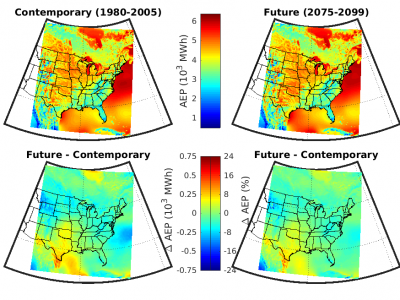Assessing the Stability of Wind Resource and Wind Turbine Operating Conditions
We present simulations with the Weather Research and Forecasting (WRF) model and use them to quantify the spatiotemporal variability in one aspect of wind turbine operating conditions (extreme wind speeds) and possible changes in the magnitude and interannual variability of expected wind power generation.
Wind energy is both a key potential mechanism to reduce climate forcing and a ‘weather-dependent’ energy source. We are advancing techniques to better project how climate change may impact either wind energy resources or operating conditions.
Wind conditions vary across a wide array of spatial and temporal scales. Despite the transformations of the energy sector that have been achieved to date and the resulting mitigation of climate change, climate variability due to moderate to low-frequency modes (e.g. El Niño Southern Oscillation, ENSO; Arctic Oscillation, AO; Pacific-North American, PNA, and the North Atlantic Oscillation, NAO, modes) and non-stationarity of the climate system due to rising concentrations of greenhouse gasses are inevitable. Both impose substantial long-term (annual to decadal) variability and changes on wind climates in the mid-latitudes. This prompts questions regarding both (a) the current magnitude and variability of wind resources (and annual energy production (AEP) from wind turbines) and operating conditions and (b) the potential for future changes in wind resources and operating conditions (e.g. extreme wind speeds) and the consequences of that variability and change for the Levelized cost of energy from wind turbines (WTs).
We perform and present moderate resolution (12 km), long-term simulations with WRF and develop new analysis approaches to assess how CREDIBLE projections of wind resources or operating conditions are. Preliminary results based on a single model chain (i.e. one GCM downscaled with WRF for one RCP) indicate evidence for increasing wind resource in the southern Great Plains and declines in the upper Midwest by the end of the current century. The magnitude of these projected differences are smaller than current inter-annual variability. Uncertainty in projections of the extreme operating wind speed is larger and the model chain exhibit important spatial variability in terms of the fidelity of the simulations of the causes of extreme wind events and thus the credibility of future projections.

